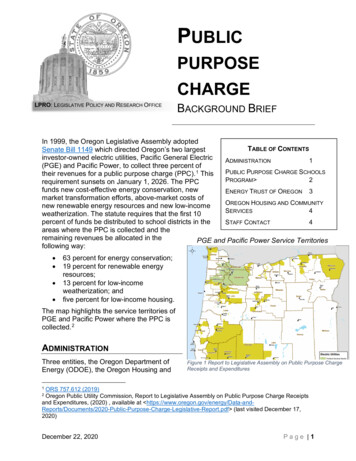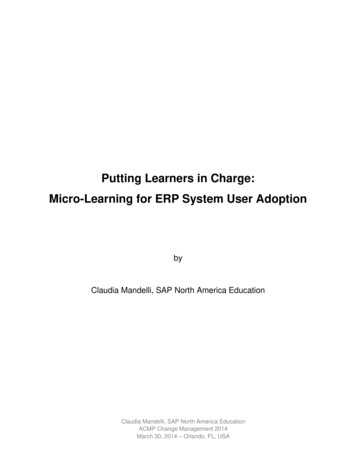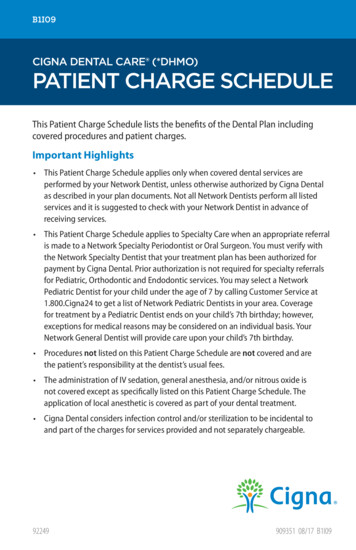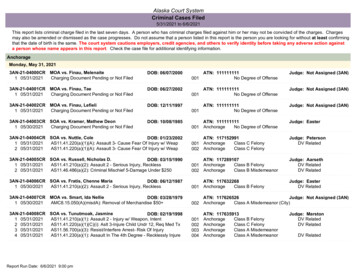
Transcription
PUBLICPURPOSELPRO: LEGISLATIVE POLICY AND RESEARCH OFFICECHARGEBACKGROUND BRIEFIn 1999, the Oregon Legislative Assembly adoptedTABLE OF CONTENTSSenate Bill 1149 which directed Oregon’s two largestinvestor-owned electric utilities, Pacific General ElectricADMINISTRATION1(PGE) and Pacific Power, to collect three percent ofPUBLIC PURPOSE CHARGE SCHOOLStheir revenues for a public purpose charge (PPC). 1 ThisPROGRAM 2requirement sunsets on January 1, 2026. The PPCfunds new cost-effective energy conservation, newENERGY TRUST OF OREGON 3market transformation efforts, above-market costs ofOREGON HOUSING AND COMMUNITYnew renewable energy resources and new low-incomeSERVICES4weatherization. The statute requires that the first 10percent of funds be distributed to school districts in the4STAFF CONTACTareas where the PPC is collected and theremaining revenues be allocated in thePGE and Pacific Power Service Territoriesfollowing way: 63 percent for energy conservation;19 percent for renewable energyresources;13 percent for low-incomeweatherization; andfive percent for low-income housing.The map highlights the service territories ofPGE and Pacific Power where the PPC iscollected. 2ADMINISTRATIONThree entities, the Oregon Department ofEnergy (ODOE), the Oregon Housing andFigure 1 Report to Legislative Assembly on Public Purpose ChargeReceipts and ExpendituresORS 757.612 (2019)Oregon Public Utility Commission, Report to Legislative Assembly on Public Purpose Charge Receiptsand Expenditures, (2020) , available at t.pdf (last visited December 17,2020)12December 22, 2020Page 1
BACKGROUND BRIEFLPRO:POLICYANDANDRESEARCHOFFICELPROL: EGISLATIVELEGISLATIVEPOLICYRESEARCHOCommunity Services (OHCS) and an independent nonprofit organization, the EnergyTrust of Oregon, are responsible for administering or overseeing programs toaccomplish the statutory public purposes of the PPC. The figure below shows theallocation of PPC funds between the three entities from July 2017 – June 2019. Thetotal collected during this period was 188,452,312. 3Total Fund Allocation 2,231,846 2,701,767 18,860,446Energy Trust of Oregon: ConservationEnergy Trust of Oregon: RenewablesOHCS: Low-Income Housing 22,070,767 8,489,462 29,879,162OHCS: Low-Income Weatherization 104,218,836ODOE: Self-Direct Customers ConservationODOE: Self-Direct Customers - RenewablesODOE: School DistrictsFigure 2: Report to Legislative Assembly on Public Purpose Charge Receipts and ExpendituresPUBLIC PURPOSE CHARGE SCHOOLS PROGRAMODOE facilitates the administration of the PPC Schools Program, by approvingreimbursement to the 111 school districts within PGE and Pacific Power’s territory.Those districts collectively receive the first 10 percent of PPC funds to be used tocomplete energy audits and implement energy efficiency measures in school buildings.Energy efficiency projects can include new windows, upgraded heating and coolingsystems, building envelope improvements, energy efficiency lighting, and domestic hotwater systems. 4 In order to receive PPC funds, schools must have a qualified firmcomplete an energy audit, implement the identified efficiency measures, report finalcosts, and report monthly energy use information annually.According to the Report to Legislative Assembly on Public Purpose Charge Receiptsand Expenditures (Report) during the July 2017 – June 2019 biennium, the program3 Oregon Public Utility Commission, Report to Legislative Assembly on Public Purpose Charge Receiptsand Expenditures, (2020) , available at t.pdf (last visited December 17,2020)4 Oregon Department of Energy, Public Purpose Charge (SB 1149) Schools Program, available at SB1149.aspx (last visited December 17, 2020)December 22, 2020Page 2
LPRO:POLICYANDANDRESEARCHOFFICELPROL: EGISLATIVELEGISLATIVEPOLICYRESEARCHOBACKGROUND BRIEFfunded the completion of 89 audits across 24 school districts and the installation of 123energy efficiency measures which were estimated to save 3,004,814 kWh in electricityand 148,100 therms of natural gas annually. School districts have realized a totalsavings of 342,441 each year as a result of the installed measures.SELF-DIRECT PROGRAMAs a part of the PPC program, large commercial and industrial consumer sites (over8,760,000 kWh in the prior year) may be eligible for the Large Electric Consumer PublicPurpose Program, also known as the Self-Direct Program. According to the Report,eligible certified sites can submit conservation and renewable project applications toODOE to be pre-certified. Once the project is completed, they can apply to ODOE forcredit. Renewable energy credits come from either on-site renewable energy generationprojects or by purchasing renewable energy certificates (RECs or Green Tags). Ifapproved, they offset the monthly conservation and renewable portion of the PPC.During the period July 2017 – June 2019, there were 76 self-directing sites,representing 66 companies, that self-directed either the conservation, renewable, orboth portions of the PPC. There were seven certified conservation projects during thissame period with a combined impact of 6,427,900 kWh in reduced energy consumptionand 406,447 in energy savings annually. Some of these conservation projects werecompleted outside of PGE and Pacific Power territories. There were 69 sites thatpurchased RECs/ Green Tags to fulfill their renewables obligation; in total, thisrepresented over 481 million kWh of renewable energy.ENERGY TRUST OF OREGONEnergy Trust of Oregon (Energy Trust) was designated by the Oregon Public UtilityCommission (PUC) to administer the conservation and renewable resource componentsof the PPC. Energy Trust provides information, financial incentives, and technicalassistance to individuals, businesses and communities. Energy Trust is tasked withacquiring all cost-effective energy efficiency in PGE and Pacific Power territories. Toachieve this goal, funding for Energy Trust comes from both the fixed annual funding ofthe PPC and by variable annual funding through SB 838. These SB 838 funds coveradditional cost-effective energy efficiency acquisition not covered by the annual PPCfunding.Through regulatory agreements with the natural gas investor-owned utilities the PUCexpanded the scope of Energy Trust services to NW Natural, Cascade Natural Gas, andAvista. The funding of Energy Trust’s gas energy efficiency activities is outside of thePublic Purpose Charge legislation.In addition to efficiency services, Energy Trust also supports small renewable projectsthrough the renewables portion of the Public Purpose Charge. These systems includerooftop solar, biopower combined heat and power systems, and micro hydropowerplants connected to either PGE or Pacific Power. Energy Trust is required to achieveannual minimum performance measures, report quarterly and annually to the PUC,December 22, 2020Page 3
LPRO:POLICYANDANDRESEARCHOFFICELPROL: EGISLATIVELEGISLATIVEPOLICYRESEARCHOBACKGROUND BRIEFprovide draft and final budgets to the PUC, create a strategic plan every five years, andcontract for an independent management audit every five years.According to the Report, Energy Trust’s PPC-funded programs accounted for421,973,037 kWh in energy savings across both the PGE and Pacific Power serviceterritories for the 2017-2019 biennium. In addition, Energy Trust invested PPC fundingin renewable energy project installations using solar, hydropower, and biopower, and aswell as project development assistance for projects that would create renewable energythrough hydropower, biopower, geothermal, and municipal-owned community windresources in order to reduce early-stage development barriers for projects, like systemsin the Community Solar Program.OREGON HOUSING AND COMMUNITY SERVICESThe Oregon Housing and Community Services (OHCS) administers programs partiallyfunded by PPC that provide financial support and resources for Oregonians of lowerand moderate income. According to the Report, the Housing Development GrantProgram, commonly known as the Housing Trust Fund, is designed to expand thestate’s supply of housing for low- and very low-income families and individuals. TheHousing Trust Fund receives 4.5 percent of PPC funds. The program’s purpose is toprovide grants and loans to construct new, acquire, and/or rehabilitate housing. Theprogram includes affordability requirements based on eventual occupancy. During the2017-2019 biennium, there were three low-income housing projects (207 units).The Low-Income Weatherization program receives 11.7 percent of PPC revenues andis designed to reduce the energy usage and utility costs of lower-income tenantsresiding in affordable rental housing. In addition, the Low-Income Weatherizationprogram provides home weatherization for single- and multi-family, owner occupied,and rental housing. The use of these grant funds includes affordability requirementsbased on eventual occupancy.According to the Report, the Low-Income Weatherization program helped fund 1,523units with a total job investment of over 11,756,106, saving over 18,679,380 millionkWh. The nine multifamily rental Low-Income Multifamily Weatherization projectsresulted in 2,034,219 kWh in annual energy savingsNote: The Oregon Public Utilities Commission (PUC) contracted with EvergreenEconomics to prepare a report to the Oregon Legislature documenting PPC receiptsand expenditures. This brief relied heavily on the analysis provided by the Report toLegislative Assembly on Public Purpose Charge Receipts and Expenditures. The reportis available at t.pdf STAFF CONTACTBeth Reiley, LPRO AnalystDecember 22, 2020Page 4
LPRO:POLICYANDANDRESEARCHOFFICELPROL: EGISLATIVELEGISLATIVEPOLICYRESEARCHOBACKGROUND BRIEFLegislative Policy and Research vPlease note that the Legislative Policy and Research Office provides centralized, nonpartisanresearch and issue analysis for Oregon’s legislative branch. The Legislative Policy and ResearchOffice does not provide legal advice. Background Briefs contain general information that is currentas of the date of publication. Subsequent action by the legislative, executive, or judicial branchesmay affect accuracy.December 22, 2020Page 5
Dec 22, 2020 · contract for an independent management audit every five years. According to the Report , Energy Trust ’s PPC-funded programs accounted for 421,973,037 kWh in energy savings across both the PGE and Pacific Power service territories for the 2017- 2019 biennium. In addition, Energy Trust invested PPC funding











